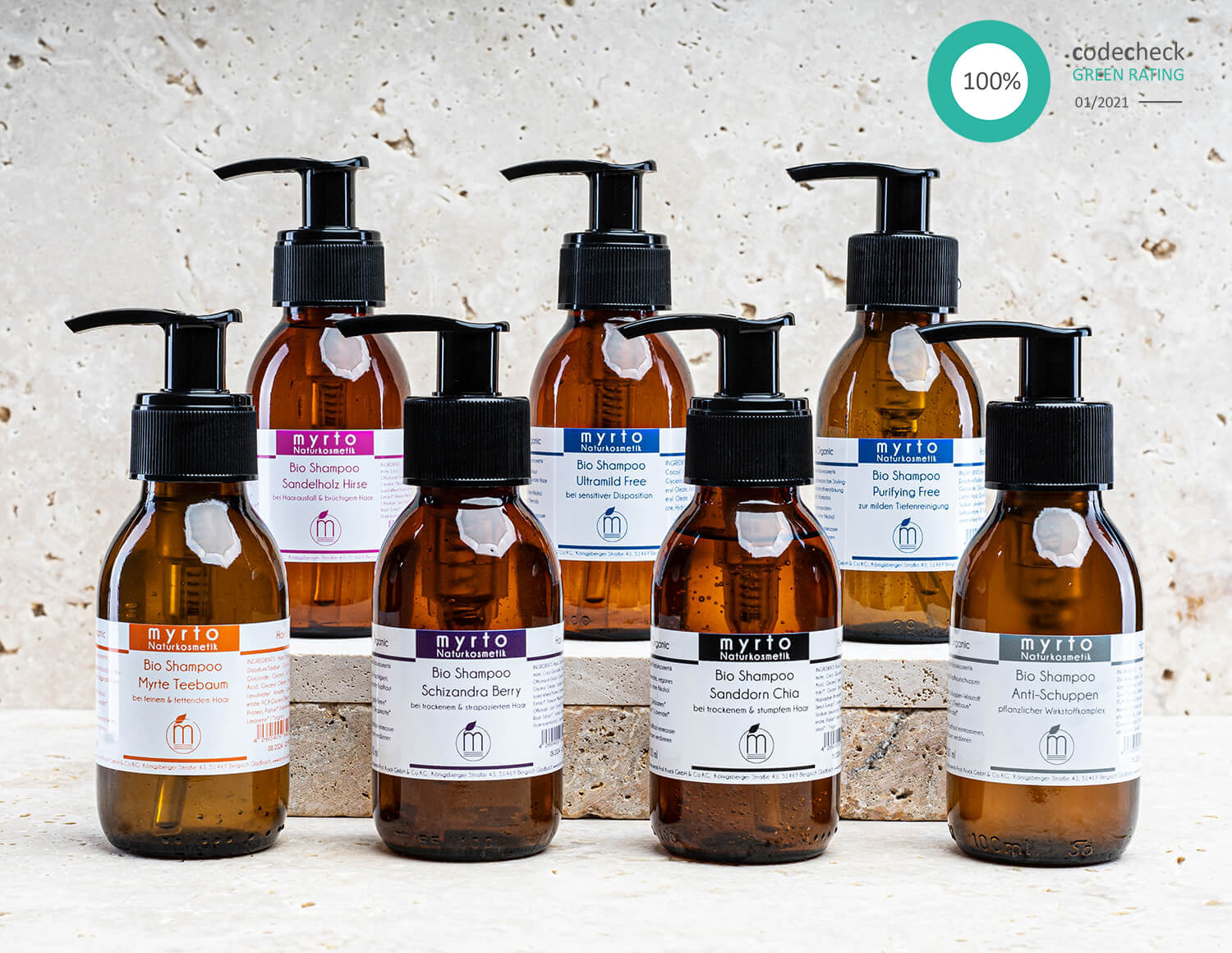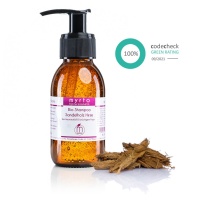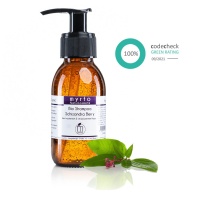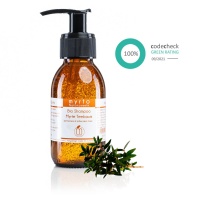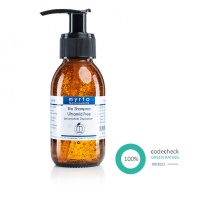The advertising consistently promises us mild, skin-gentle shampoos that are supposed to give our hair volume, structure and shine and are also supposed to improve combability. Clear videos and before and after photos are intended to convince us and persuade us to buy the advertised product. Unfortunately, the vast majority of shampoos contain aggressive chemicals that harm our health and pollute the environment. The dangerous thing is that the health damage does not occur immediately after use, but accumulates over the course of life. This makes it so difficult to identify the true causes.
Our most important tip: Check the ingredients
It's worth it if you carefully check each individual ingredient in your shampoo using the ingredients list (INCI) on the packaging, for example with the help of the Codecheck app or Skin protection angel .de. This way you can avoid substances that are harmful to your health and distinguish a high-quality product from an inferior one.
In the following overview we list the 13 most important harmful ingredients in shampoos. You should definitely avoid these pollutants:
1. Lauryl sulfates (SLS, SLES) - irritating to the skin and drying out the scalp.
INCI: Sodium Lauryl Sulfate (SLS), Sodium Laureth Sulfate (SLES)
The foaming agents SLS (Sodium Lauryl Sulfate) and SLES (Sodium Laureth Sulfate) are based on ethoxylated (alcoholic) petroleum derivatives. The manufacturing process produces the dangerous chemical dioxane as a byproduct, which is considered to be carcinogenic. Lauryl sulfates are not only used in shampoos, liquid soaps and bubble baths, but even in toothpastes.
Lauryl sulfates have a drying and irritating effect on skin and mucous membranes. Although they thoroughly remove greasy dirt particles, they loosen the protective barrier layer on the skin's surface. As a result, the skin tends to itch, flakes, redness or eczema. In addition, lauryl sulfates make the skin permeable to pollutants, which are then stored in the organs. Lauryl sulfates are also questionable from an ecological point of view, as they hardly break down in the environment and pollute waterways.
2. Silicones — clog the pores of the scalp and weigh down the hair
INCI: Endings with “–cone” or “–xane
On the INCI list you can recognize silicones by the endings “–cone” or “–xane”.
Silicones simulate healthy hair by making the hair look smooth and shiny for a short time. In fact, silicones seal the scalp and form a film around each individual hair. Since silicones are not water-soluble, they cannot simply be washed out with hair washing. An increasingly thick silicone layer accumulates on the scalp and hair fiber (build-up effect). The hair becomes increasingly dry and weighed down, the roots appear flat and without volume. Silicones clog the pores of the scalp, promoting impurities and pimples. Silicones are not degradable in the environment, especially if they enter waterways via sewage treatment plants.
3. Polyquaternium / Quats — Skin irritations and allergic reactions
INCI: Polyquaternium-37, Polyquaternium-7, Quaternium-15, Quaternium-31, Quaternium-60
Polyquaternium and quaternium, briefly called polyquats and quats, plus a number each, are also synthetic hair care ingredients. Examples are: Polyquaternium-37, Polyquaternium-7, Quaternium-15, Quaternium-31, Quaternium-60.
Quats - similar to silicones - are intended to make the hair easy to comb, shiny and prevent electrostatic charging. However, polyquaternium can also cause skin irritations and allergic reactions. In addition, Quats / Polyquats are hardly biodegradable. With the wastewater they end up in rivers, lakes and seas, and ultimately in the groundwater.
4. Mineral oil – clogs pores and accelerates skin aging
INCI: Paraffinum Liquidum, Petrolatum
On the ingredients list of cosmetic packaging, mineral oil is declared as paraffinum liquidum or petrolatum. Mineral oil is used in shampoos as an emollient and moisturizer. is a synthetic oil — i.e. the same petroleum that is used to make plastic and car fuel. Mineral oil can contain residues of carcinogenic formaldehyde and dioxane. Mineral oil does not contain any minerals, vitamins or nutrients. Mineral oil is a cheap substitute for high-quality vegetable oils. It does not provide any benefit to the skin. Mineral oil is comedogenic. This means that it clogs the pores of the skin and hinders the skin's natural breathing, so that toxins cannot be excreted through the skin. This results in skin problems such as pimples, dandruff and accelerated skin aging.
5. Parabens — hormonally active, irritating to the skin and increased allergy potential
INCI: Benzylparaben, Butylparaben, Ethylparaben, Isobutylparaben, Heptylparaben, Methylparaben or Propylparaben
The most common names to look for on the INCI list are benzylparaben, butylparaben, ethylparaben, isobutylparaben, heptylparaben, methylparaben or propylparaben. Parabens are widely used synthetic preservatives to extend the shelf life of shampoos and prevent the growth of mold or bacteria.
Parabens are similar to the female hormone estrogen and can act as endocrine disruptors. For example, they can promote breast development and feminization in men. In women, estrogen dominance as a result of hormonal imbalance can lead to mood swings, PMS (premenstrual syndrome), and breast or uterine cancer. In addition, parabens are considered contact allergens that can trigger allergic reactions on the scalp. It is also worrying that parabens cannot be broken down in the environment and are increasingly accumulating in nature.
6. PEGs — Skin and eye irritation, allergic reactions, sensitization
INCI: PEG“-xxx as a prefix, or xxx–“eth” as ending, e.g. Sodium Laureth Sulfate (SLES), Ceteareth-33 or Polysorbates, Copolyol, Polyglycol
PEG is the abbreviation for polyethylene glycol. The extremely reactive synthetic substances are used as emulsifiers, solubilizers, consistency agents or pearlescent in shampoos, skin creams, deodorants or toothpaste. PEG compounds damage the membrane function of the skin, soften the cell walls and make them permeable to the penetration of pollutants. Possible consequences include skin irritation, allergies, neurodermatitis, redness of the mucous membranes and eyes or headaches. PEGs accelerate skin aging. They are made from the highly toxic gas ethylene oxide - an extremely reactive chemical that is considered to be potentially mutagenic, teratogenic and carcinogenic. PEGs are extremely harmful to the environment. It can take many decades for these chemicals to be completely broken down by microorganisms.
How can you recognize PEGs or PEG derivatives? On the one hand, it is the prefix “ PEG” in the ingredients list of cosmetics, for example. PEG Stearate, PEG-55 Propylene, PEG-3 Distearate, PEG-12 Dimethicone, PEG-41 Aminoethyl. on the other hand, ingredients that contain “eth” end, on PEGs. Examples are sodium laureth sulfate (SLES), ceteareth-33 or also: polysorbates, copolyol and polyglycol.
7. Phthalates — endocrine disruptors and allergic reactions
INCI: Dibutyl phthalate (DBP), dimethyl phthalate (DMP) or diethyl phthalate (DEP)
Phthalates are a group of chemicals that are found as plasticizers and solvents in soaps, cleaning products and also in shampoos. On the ingredients list, phthalates are declared, for example, as dibutyl phthalate (DBP), dimethyl phthalate (DMP) or diethyl phthalate (DEP).
Research suggests that phthalates are hormonally active, have estrogenic effects, and may act as endocrine disruptors. This affects premature sexual maturation in children, but also hormonal diseases such as diabetes, obesity, cardiovascular diseases or certain tumors. The phthalates DEHP, DBP, BBP, and DIBP are classified as toxic to reproduction (toxic to reproduction). In animal experiments, the phthalate DPHP has a damaging effect on vital endocrine glands, the thyroid and the pituitary gland. Other phthalates cause damage to the liver, kidneys and testicles.
8. Ethanolamines — skin irritation, eye irritation, carcinogenic
INCI: diethanolamine (DEA), triethanolamine (TEA), nitrosodiethanolamine (NDEA), TEA lauryl sulfate, MEA, DEA cetyl phosphate, cocamide MEA
Common names include diethanolamine (DEA), triethanolamine (TEA), nitrosodiethanolamine (NDEA), TEA lauryl sulfate, MEA, DEA cetyl phosphate, cocamide MEA.
Ethanolamines serve as surfactants, plasticizers, stabilizers, emulsifiers and humectants. They irritate the mucous membranes and have an allergenic effect. These pollutants in hair shampoo often react with other chemical ingredients and form dangerous nitrosamines. Nitrosamines are considered to be highly carcinogenic. They can cause permanent damage to the genetic material, liver and kidneys. DEA and TEA severely dry out skin and hair. Ethanolamines are known to be toxic to the environment.
9. EDTA (ethylenediaminetetraacetic acid) - allergic reactions, itching, skin rashes
INCI: : Ethylene-Diamino-Tetra-Acetate; Disodium EDTA, Tetrasodium EDTA or Sodium EDTA
EDTA is a petroleum-based chemical compound that is extremely reactive. In shampoos, it quickly combines with other harmful substances such as parabens or chemical UV filters and introduces them into the body. EDTA promotes allergic reactions such as rashes, redness and itching. It accumulates in the body. EDTA is considered to be toxic to the environment.
10. formaldehyde releasers - Skin irritations, allergic reactions, potentially carcinogenic
INCI: DMDM Hydantoin, Diazolidinyl Urea, Sodium Hydroxymethyl Glycinate, 2-bromo-2-nitropropane-1,3-diol (Bromopol), Imidazolidinyl Urea, Bronidox, 5-Bromo-5-Nitro-1 ,3-Dioxane
Formaldehyde releasers contain formaldehyde in bound form. They have a strong bactericidal and fungicidal effect and are therefore used as antimicrobial agents for preservation in cosmetics such as shampoos. When you wash your hair with a shampoo that contains formaldehyde, the pollutant is released onto the (scalp) skin. Even in small doses, formaldehyde irritates the mucous membranes, causes the skin to age more quickly, and can cause hair loss and allergies. DMDM hydantoin has been classified as a potential carcinogen.
11. Propylene glycol (PG) - Skin irritation and systemic damage
INCI: Propylene glycol (PG), 1,2-propanediol, propylene glycol, dicaprylate/dicaprate.
PG is made from petroleum and is intended to serve as a humectant in shampoos. Notorious because of its high irritant potential, propylene glycol can enter the body through the skin, where it weakens cell structures and can cause nausea and headaches. With long-term use, PG can cause liver and kidney damage.
12. Synthetic fragrances — allergic irritation potential, toxic and environmental effects
Synthetic fragrances consist of a variety of chemical compounds and are intended to mask the unpleasant smell of other chemicals contained in shampoos and other cosmetics. They may cause respiratory irritation, headaches, dizziness, nausea or skin rashes. In addition to a high allergy potential, some artificial fragrances have also been shown to have toxic, carcinogenic, genetically damaging effects in animal experiments. Some synthetic fragrances accumulate in fatty tissue and can even be detected in breast milk. They are also hardly degradable in the environment.
Synthetic dyes are petroleum-based chemicals. They are used for purely visual reasons to make a product look more attractive for sale. You can recognize synthetic dyes in cosmetics by the abbreviation CI (= Color Index) with a 5-digit number after it, for example the red azo pigment CI 18050 or CI 19140 for the yellow tatrazine. Both ingredients are questionable. Azo pigments in particular have a high allergy potential and can be carcinogenic.
Synthetic dyes have been linked to serious health problems. Some are suspected of promoting allergies, causing hyperactivity and attention deficit disorder in children, or having a carcinogenic effect.
Conclusion
As you can see, standard shampoos contain many harmful substances that you should definitely avoid. Therefore, all myrto organic shampoos contain exclusively natural and harmless ingredients whose particularly good skin compatibility has been proven and tested over many years. As with all myrto products, our organic shampoos consistently avoid any questionable substances in order to ensure long-term, healthy care for your scalp and hair.
Always be extremely critical when choosing your hair and hair care products. You also can't trust the many different natural cosmetics seals alone, because there are no uniform standards. Current natural cosmetics seals are anything but transparent and are sometimes difficult to understand. All seals are awarded by private companies for profit. Natural cosmetics seals serve manufacturers primarily as a marketing strategy to gain trust from buyers. Natural cosmetics seals can offer you an initial guide when selecting products. But they also offer enough scope to use cheap ingredients where the long-term care effect and your skin health are not the top priority. Therefore, check each individual ingredient carefully to ensure that your skin or body cannot be harmed by any of the ingredients.


